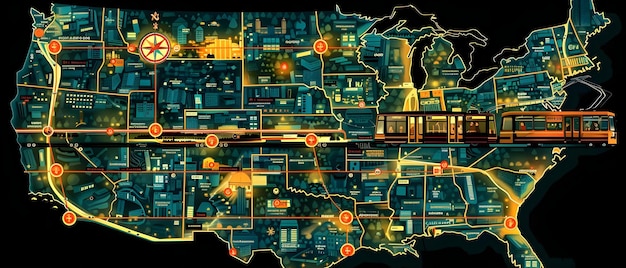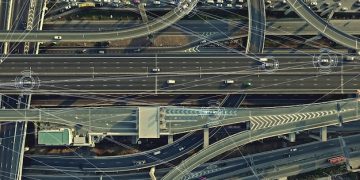Congress Passes $2B Infrastructure Bill: National Impact?

The recent congressional approval of a $2 billion infrastructure bill is poised to significantly reshape various facets of the nation, from economic growth and job creation to environmental rehabilitation and societal well-being, demanding a comprehensive understanding of its widespread implications.
In a landmark legislative decision that reverberated across Capitol Hill, the United States Congress recently passed a substantial $2 billion infrastructure bill. This pivotal moment signals a renewed national commitment to upgrading America’s foundational systems. But beyond the headlines, how precisely will this significant investment influence the nation’s communities, economy, and everyday lives?
The Road to Renewal: Unpacking the Infrastructure Legislation
The journey to legislative approval for this considerable infrastructure package was complex, involving extensive debate, negotiation, and amendments. Understanding the core elements of the bill is crucial to appreciating its potential reach and impact. Far from a simple allocation of funds, this legislation represents a strategic investment in the nation’s future, designed to address decades of underfunding and deferred maintenance across critical sectors.
Initial discussions for such a comprehensive bill spanned several years, often facing partisan gridlock. However, a growing consensus regarding the pressing need for modern infrastructure eventually paved the way for bipartisan efforts. Lawmakers from both sides of the aisle recognized the deteriorating state of roads, bridges, public transit, and crucial utilities, acknowledging that neglecting these assets hampers economic competitiveness and public safety.
Key Pillars of the Legislation
The $2 billion allocation is not a monolithic sum but rather a carefully distributed investment across several key areas. Each pillar targets specific infrastructure deficiencies, aiming for both immediate improvements and long-term sustainability.
- Transportation Networks: A significant portion is earmarked for repairing and upgrading existing roadways, bridges, and tunnels, many of which are deemed structurally deficient or functionally obsolete. This also includes investments in public transportation systems, aiming to enhance connectivity and reduce congestion in urban and suburban areas.
- Digital Connectivity: Recognizing the critical role of broadband in modern life, the bill allocates substantial funds to expand access to high-speed internet, particularly in underserved rural and tribal communities. This aims to bridge the digital divide, fostering economic opportunity and educational parity.
- Water and Wastewater Systems: Investments are directed towards modernizing aging water pipes, wastewater treatment facilities, and lead pipe replacement initiatives. Ensuring access to clean, safe drinking water is a fundamental public health concern addressed by this component.
- Power Grid and Clean Energy: The legislation supports upgrades to the national power grid to enhance its resilience against extreme weather events and cyberattacks. It also promotes the development and deployment of clean energy technologies, aligning with broader climate goals and fostering a more sustainable energy future.
The scope of this bill extends beyond mere repair work; it’s about building for the next generation. The emphasis is on smart infrastructure, incorporating new technologies to improve efficiency, safety, and environmental performance. This forward-looking approach ensures that the investments made today will yield benefits for decades to come, positioning the nation competitively on a global scale.
Ultimately, the approval of this significant infrastructure bill signifies a collective understanding of the vital link between robust infrastructure and national prosperity. It sets a new course for domestic policy, prioritizing long-term investment over short-term fixes, and laying the groundwork for a more connected, resilient, and sustainable future across the United States.
Economic Ripples: Jobs, Growth, and Local Economies
The approval of the $2 billion infrastructure bill is poised to send substantial economic ripples throughout the nation. Far from being a static investment, this funding is designed to catalyze growth, create jobs, and stimulate local economies in profound ways. Its impact will be felt across various sectors, from the construction industry to technology and beyond, creating a dynamic environment for economic revitalization.
One of the most immediate and tangible effects will be a significant surge in job creation. Infrastructure projects are inherently labor-intensive, requiring a vast workforce across diverse skill sets. This will not only alleviate unemployment in certain sectors but also generate new opportunities for training and skill development, fostering a more robust and adaptable labor force.
Direct and Indirect Job Creation
The job market will see both direct and indirect benefits stemming from this bill. Direct jobs include those directly involved in construction, engineering, and project management.
- Construction Workers: A massive demand for skilled laborers, equipment operators, and site managers will arise as new projects commence.
- Engineers and Architects: Professional services for design, planning, and oversight will see increased demand.
- Manufacturing and Suppliers: The need for materials—steel, concrete, telecommunications equipment, and energy components—will boost manufacturing and related supply chains.
Beyond these direct roles, countless indirect jobs will emerge to support these activities. Logistics, hospitality, and local retail will experience increased activity as workers relocate or spend more in project areas. This multiplier effect means the impact on employment will be broad and deep, extending far beyond the immediate construction sites.
Moreover, improved infrastructure often leads to enhanced productivity and reduced operational costs for businesses. Better transportation networks mean more efficient movement of goods and services, lowering supply chain costs and improving market access. Reliable broadband fosters innovation and allows businesses to expand their reach, particularly in previously underserved areas. A modernized power grid ensures stable energy supply, preventing costly disruptions and supporting energy-intensive industries.
Individual regions and local economies stand to benefit significantly, especially those with aging infrastructure or limited access to modern amenities. Rural communities, for instance, will gain from expanded broadband access, which can attract new businesses, support remote work, and enhance agricultural efficiency through precision farming technologies. Urban centers will see revitalized public transit systems reduce commuting times and environmental impact, making cities more attractive for residents and investors.

The economic impact of this bill is not merely about spending; it’s about strategic investment that yields long-term returns. By improving the fundamental building blocks of the economy, the nation positions itself for sustained growth, greater resilience, and enhanced global competitiveness. This infusion of capital is designed to create a virtuous cycle where improved infrastructure drives economic activity, which in turn supports further investment and innovation, cementing a more prosperous future for all American communities.
Environmental Footprint: From Grey to Green Infrastructure
The $2 billion infrastructure bill, while focused on tangible assets, carries a significant commitment to reducing the nation’s environmental footprint and fostering a transition towards greener, more sustainable practices. This aspect of the legislation reflects a growing recognition that infrastructure development must align with ecological stewardship and climate resilience. The emphasis isn’t solely on “grey infrastructure” like roads and bridges, but increasingly on “green infrastructure” solutions that benefit both the economy and the environment.
A substantial portion of the bill is dedicated to projects that directly mitigate climate change impacts or enhance environmental quality. This includes investments in renewable energy sources, energy efficiency upgrades, and infrastructure designed to withstand the increasingly severe effects of climate change, such as extreme weather events.
Prioritizing Sustainable Solutions
The shift towards sustainable infrastructure is evident in how funds are allocated and the types of projects prioritized.
- Clean Energy Transition: Funds are earmarked for developing and deploying renewable energy projects, including solar and wind farms, as well as upgrading the grid to better integrate these sources. This directly reduces reliance on fossil fuels and lowers greenhouse gas emissions.
- Public Transit Expansion: Enhancing and expanding public transportation reduces the number of single-occupancy vehicles on the road, thereby decreasing traffic congestion, fuel consumption, and air pollution.
- Water Quality Improvement: Investments in modernizing water and wastewater treatment facilities will lead to cleaner waterways and healthier ecosystems. Replacing lead pipes, for instance, not only protects public health but also prevents environmental contamination.
Furthermore, the bill encourages the adoption of environmentally friendly construction practices and materials. This includes promoting the use of recycled materials, reducing construction waste, and implementing designs that minimize ecological disruption. Incentives are often built into the funding mechanisms to encourage states and local governments to pursue projects with higher environmental standards.
The legislation also addresses the need for greater resilience against climate-related disasters. As weather patterns become more unpredictable, infrastructure must be built to withstand floods, droughts, wildfires, and extreme temperatures. This includes investing in natural infrastructure solutions such as wetlands restoration for flood protection, tree planting for heat island mitigation, and coastal protection measures.
By investing in green infrastructure, the bill not only addresses pressing environmental challenges but also unlocks new economic opportunities in clean energy, environmental engineering, and sustainable development. This dual benefit—environmental protection coupled with economic growth—positions the nation at the forefront of a global shift towards a more sustainable and resilient future. The emphasis on environmental responsibility within this infrastructure bill underscores a comprehensive approach to national development that considers both present needs and future planetary health.
Societal Impact: Community Well-being and Equity
Beyond the concrete and steel, the $2 billion infrastructure bill has profound implications for societal well-being and equity across the nation. At its core, infrastructure is about people—connecting them, providing essential services, and fostering environments where communities can thrive. This legislation aims to address long-standing disparities and improve the quality of life for millions of Americans, particularly in underserved regions.
Access to reliable infrastructure is a foundational element of social equity. Communities lacking adequate transportation, clean water, or high-speed internet often face significant disadvantages in terms of economic opportunity, education, and health outcomes. This bill seeks to rectify these imbalances by directing resources to areas that have historically been left behind, ensuring that the benefits of modern infrastructure are more broadly shared.
Bridging Disparities and Enhancing Lives
The investments are strategically designed to deliver tangible improvements to everyday life, fostering a more equitable society.
- Improved Health Outcomes: Modernized water infrastructure, particularly the replacement of lead pipes, directly enhances public health by ensuring access to safe drinking water, reducing the incidence of lead poisoning and related health issues, especially in vulnerable populations.
- Educational Opportunities: Universal broadband access means students in rural and low-income areas can participate fully in online learning, access digital resources, and bridge the homework gap. This levels the playing field for educational attainment.
- Enhanced Public Safety: Safer roads, bridges, and public transit systems reduce accidents and improve emergency response times. Resilient infrastructure also provides greater protection during natural disasters.
The bill also prioritizes community engagement and input in project planning and execution. This ensures that infrastructure projects are not merely built for communities, but with them, tailoring solutions to specific local needs and priorities. Such an approach fosters a sense of ownership and ensures that investments are truly responsive to the people they serve.
Moreover, the creation of numerous jobs through these infrastructure projects will disproportionately benefit communities that have faced higher unemployment rates or limited economic prospects. These jobs can provide pathways to stable careers, reduce poverty, and strengthen local economies from the ground up, contributing to a more resilient social fabric. The focus on workforce development and training programs within the bill further ensures that these opportunities are accessible to a diverse range of individuals, including those transitioning from other industries or seeking new skills.
By focusing on fundamental needs and prioritizing equitable access, the infrastructure bill has the potential to significantly improve the daily lives of countless Americans. It aims to build more connected, healthier, and safer communities, ensuring that the benefits of national progress are inclusive and accessible to everyone, regardless of their geographic location or socioeconomic status. This holistic approach to infrastructure development positions it not just as an economic endeavor, but as a crucial pillar of social justice and collective well-being.
Implementation Challenges and Oversight Mechanisms
While the congressional approval of the $2 billion infrastructure bill is a monumental step, its successful implementation is paramount and not without its challenges. The sheer scale and complexity of coordinating thousands of projects across various states and localities will require rigorous planning, efficient resource allocation, and robust oversight to ensure funds are spent effectively and transparently. Anticipating and mitigating these hurdles is crucial for the bill to deliver its promised benefits.
One of the primary challenges lies in the coordination between federal, state, and local governments. Infrastructure projects often involve multiple stakeholders, differing regulatory frameworks, and varying local priorities. Streamlining permitting processes, fostering effective communication channels, and ensuring consistent standards across jurisdictions will be vital to avoid delays and cost overruns. This calls for unprecedented levels of intergovernmental cooperation and shared commitment.
Ensuring Accountability and Efficiency
To safeguard against waste, fraud, and abuse, comprehensive oversight mechanisms are embedded within the legislative framework.
- Dedicated Task Forces: Specialized federal task forces and review boards will monitor project progress, adherence to budgetary constraints, and compliance with environmental and labor regulations.
- Regular Audits: Both internal and external audits will be conducted at various stages of project development and completion to verify financial expenditures and validate performance metrics.
- Public Reporting: Transparency is a key component, with requirements for regular public reporting on project status, funding allocation, and achieved outcomes. This allows for public scrutiny and accountability.
Another significant challenge will be the availability of a skilled workforce. The surge in construction and engineering projects will create immense demand for trained professionals. Ensuring that vocational schools, community colleges, and apprenticeship programs can meet this demand will be critical. Investments in workforce development and training initiatives are included in the bill to help bridge this gap, but the scale of the need will require sustained effort.
Supply chain constraints also present a potential bottleneck. The increased demand for construction materials, technology components, and heavy machinery could lead to price increases or delays. Proactive measures, such as domestic sourcing preferences and strategic stockpiling where feasible, will be important to minimize disruptions and ensure projects stay on schedule and within budget.
Ultimately, the success of this infrastructure bill hinges not just on the allocation of funds, but on the meticulous execution and diligent oversight of every project. By establishing clear guidelines, promoting intergovernmental collaboration, and maintaining unwavering accountability, the nation can ensure that this historic investment truly transforms communities and strengthens the foundation for future prosperity, delivering real, tangible results for the American people.
Long-Term Vision: A More Resilient and Future-Ready Nation
The approval of the $2 billion infrastructure bill is not merely a response to immediate needs; it embodies a long-term vision for a more resilient and future-ready nation. This substantial investment is designed to lay the groundwork for sustained economic competitiveness, enhanced public safety, and a more adaptive society capable of navigating the challenges of the 21st century. It’s about strategic foresight, preparing the country for technological advancements, demographic shifts, and environmental changes that lie ahead.
A key aspect of this long-term vision is fostering innovation. By funding projects that incorporate cutting-edge technologies—from smart grid solutions and autonomous vehicle infrastructure to advanced materials and digital twin modeling for urban planning—the bill aims to position the United States as a leader in global innovation. This encourages research and development, creates new industries, and attracts talent, ensuring the nation remains competitive on the global stage.
Building for Future Generations
The investments are structured to deliver benefits that extend far beyond the immediate construction phase, creating enduring value for future generations.
- Climate Resilience: By investing in infrastructure that can better withstand extreme weather and climate impacts, the nation reduces long-term recovery costs and protects lives and livelihoods. This proactive approach builds sustained resilience against future environmental challenges.
- Economic Competitiveness: Modern, efficient infrastructure lowers business costs, improves connectivity for trade, and enhances productivity, ensuring the U.S. remains an attractive place for investment and economic activity over decades.
- Quality of Life: Improved public transit, reliable broadband, and clean water systems contribute to a higher quality of life, fostering healthier communities and providing access to essential services and opportunities for all citizens, which creates a positive cycle of growth and well-being.
Furthermore, the bill’s emphasis on digital infrastructure, particularly universal broadband access, is foundational for future growth. In an increasingly interconnected world, digital connectivity is as vital as physical roads and bridges. Ensuring that every American has access to high-speed internet enables participation in the digital economy, remote work opportunities, telehealth services, and advanced educational programs, democratizing access to future advancements.
The long-term vision also encompasses job growth in emerging green industries. By supporting renewable energy and sustainable technologies, the bill catalyzes the development of a green workforce, preparing the nation for a global economy increasingly powered by clean energy. This not only creates new job pathways but also contributes to energy independence and environmental stewardship for the decades to come.
In essence, this infrastructure bill represents a generational investment, designed to rectify past neglects while simultaneously building the foundations for a dynamic, resilient, and prosperous future. It’s a testament to the belief that strategic public investment in foundational assets is critical for national growth, security, and the well-being of its citizens, ensuring that the United States remains at the forefront of global progress for decades to come.

What’s Next: Monitoring Progress and Sustaining Momentum
With the $2 billion infrastructure bill now approved, the focus shifts from legislative debate to practical implementation. This next phase is critical, involving meticulous monitoring of progress, adapting to unforeseen challenges, and sustaining the momentum necessary to translate legislative intent into tangible benefits for the nation. The success of this historic investment hinges on continuous vigilance and a sustained commitment from all levels of government and stakeholders.
A key element of what’s next involves establishing clear benchmarks and performance metrics for each project and program. This includes setting timelines for completion, defining expected outcomes (e.g., miles of road repaired, number of homes with new broadband access, gallons of clean water delivered), and regularly assessing progress against these targets. Transparent reporting will be essential to inform the public and ensure accountability.
Crucial Steps Forward
The implementation path requires a multi-pronged approach to ensure efficiency and maximum impact.
- Continuous Oversight: Federal agencies will establish robust oversight mechanisms, including regular audits and site visits, to ensure funds are spent appropriately and projects adhere to quality standards and timelines.
- Stakeholder Engagement: Ongoing engagement with state and local governments, industry partners, labor unions, and community groups will be vital to address issues as they arise, share best practices, and foster collaborative solutions.
- Impact Assessment: Regular assessments of the bill’s economic, environmental, and societal impacts will measure its effectiveness and inform future policy decisions. This data-driven approach ensures that lessons learned from initial projects can be applied to subsequent phases.
Moreover, sustaining momentum will require political will and continuous public support. Infrastructure projects are often long-term endeavors, and maintaining consistent funding and commitment can be challenging amidst shifting political landscapes. Advocating for the continued importance of these investments and celebrating early successes will be crucial in building consensus for future phases.
Addressing unforeseen challenges, such as unexpected supply chain disruptions, fluctuating material costs, or new technological advancements, will also be part of the ongoing process. The implementation framework must be agile enough to adapt to these variables, ensuring that projects remain viable and deliver maximum value.
In the long run, the success of this bill will serve as a blueprint for future infrastructure investments, demonstrating the immense power of strategic public spending. By diligent monitoring, transparent reporting, and unwavering commitment, the nation can ensure that these $2 billion transform into a stronger, more resilient foundation for generations to come, setting a precedent for ambitious, impactful governmental action based on a clear vision for the future.
| Key Pillar | Brief Impact |
|---|---|
| 🛣️ Transportation | Upgrades to roads, bridges, and public transit boost efficiency and safety. |
| 🌐 Digital Connectivity | Expands high-speed internet access to bridge digital divides. |
| 💧 Water Systems | Modernization ensures cleaner, safer drinking water for communities. |
| 💡 Power Grid & Energy | Enhances grid resilience and promotes clean energy initiatives. |
Frequently Asked Questions (FAQ)
▼
The primary goal is to modernize and upgrade America’s aging infrastructure across various sectors, including transportation, water systems, broadband connectivity, and the power grid. This aims to stimulate economic growth, create jobs, enhance public safety, and build a more resilient and sustainable nation for the future, rectifying decades of underinvestment in foundational assets.
▼
The bill is expected to create a significant number of direct and indirect jobs. Direct jobs will be in construction, engineering, and project management. Indirect jobs will arise across supply chains, manufacturing, and local services. This widespread job creation aims to boost employment, foster skill development, and stimulate local economies across the nation.
▼
Yes, the bill explicitly incorporates environmental sustainability and climate resilience. It allocates funds for clean energy projects, upgrades to renewable energy infrastructure, and promotes environmentally friendly construction practices. It also supports projects designed to withstand extreme weather events and improve water quality, contributing to a greener national footprint.
▼
A substantial portion of the bill is dedicated to expanding access to high-speed broadband internet, particularly in rural and tribal communities that currently lack reliable connectivity. This investment aims to bridge the digital divide, providing essential access for education, remote work, telehealth, and economic opportunities that are increasingly reliant on digital infrastructure.
▼
Key challenges include coordinating projects across federal, state, and local governments, ensuring a sufficient skilled workforce, and managing potential supply chain issues. Robust oversight, transparent reporting, and effective communication will be crucial to overcome these hurdles, prevent delays, ensure efficient fund allocation, and ultimately deliver the intended benefits across the nation.
A Foundation for Future Prosperity
The approval of the $2 billion infrastructure bill marks a pivotal chapter in the nation’s ongoing development. It is more than just an allocation of funds; it represents a strategic recommitment to the foundational elements that underpin national progress. From spurring widespread economic growth and job creation to bolstering environmental sustainability and fostering greater societal equity, the multifaceted impact of this legislation cannot be overstated. While the path to full implementation will undoubtedly present complexities, the comprehensive nature of the bill and the emphasis on oversight and long-term vision position the United States for a more resilient, competitive, and inclusive future. This investment is set to transform communities and reinforce the very pillars upon which the nation’s prosperity rests.





